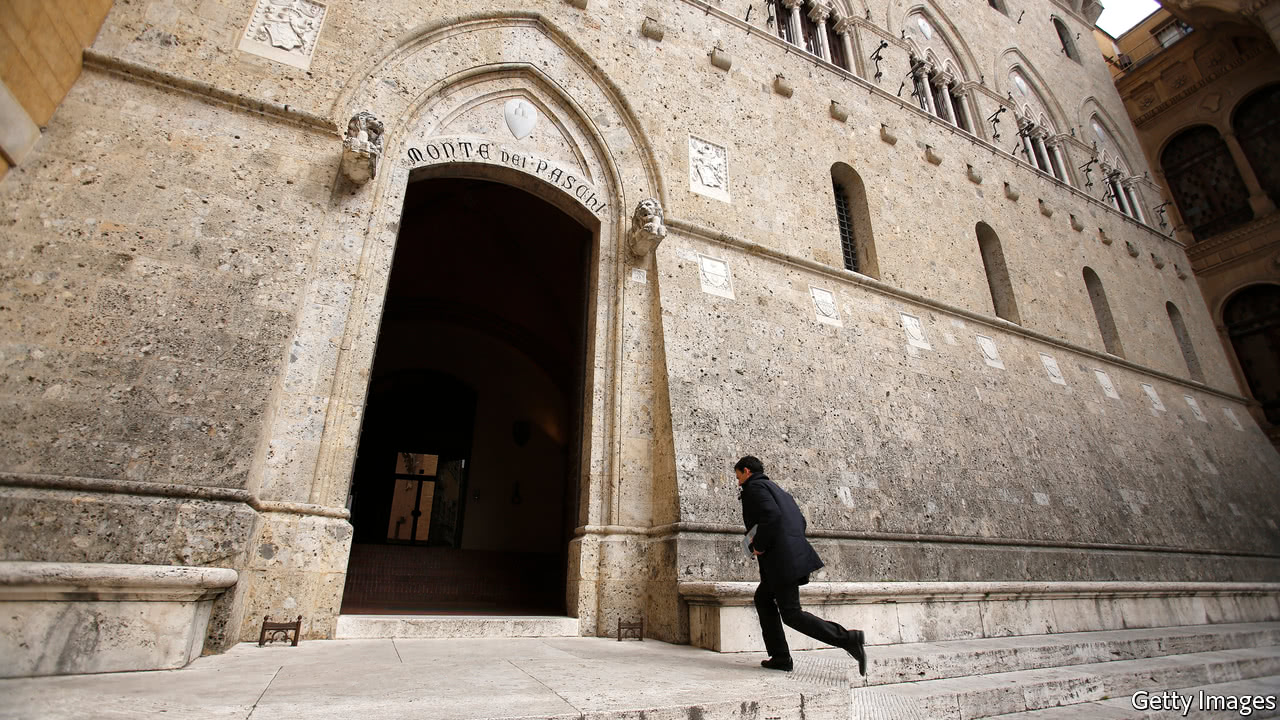
A TELEVISION advertisement for Monte dei Paschi di Siena begins with a toddler tumbling and a gymnast stumbling. “Falling is the first thing we learn,” declares the voice-over. “The second is getting up again.” Italy’s fourth-biggest bank and the world’s oldest, which was bailed out by the Italian government in July, has had several bruising falls over the years. On October 25th it returned to the stockmarket after a ten-month hiatus—the latest stage of its plan to get back on its feet. The shares closed higher on the day, at €4.55 ($5.37), but still far below the €6.49 the government paid.
Trading was suspended last December, after a failed private-sector attempt to save the bank through a share issue. The government said it would get involved. In July the European Commission approved a €8.1bn “precautionary recapitalisation”. European rules say banks receiving such aid must be solvent, the capital injection must not distort competition and the capital shortfall must be identified by a stress test, such as the one Monte dei Paschi failed in July 2016. Shareholders and junior bondholders must share the pain.
-
Full-time MBA courses
-
Catalonia’s parliament declares independence; Spain imposes direct rule
-
“Stranger Things 2” is a triumphant return to Hawkins
-
Irrationality at the voting booth
-
James Mattis visits the DMZ
-
The Reformation’s 500th anniversary has Germans arguing over holiday time
Therefore, alongside the injection of €3.9bn by the government, €4.3bn-worth of subordinated bonds are being converted to equity. Much of this is held by retail investors, many of whom may have thought they were buying a safe investment. Some of these can choose to swap their new shares for senior bonds. The exchange will run from October 30th to November 17th. If, as expected, they all make the swap, the government’s stake will rise from 52% to 68%, at an additional cost of €1.5bn. By 2021 Monte dei Paschi must return to the private sector.
The plan also disposes of €28.6bn-worth, at gross value, of non-performing loans, of which most are being offloaded into a separate vehicle and securitised. Atlante 2, a private bank-rescue fund, will buy most of the mezzanine and junior tranches for €1.6bn; the senior debt will be sold on the market, partly backed by a state-guarantee scheme.
The scheme is rounded off by the bank’s restructuring. This includes simplifying and digitising retail banking, strengthening the wealth-management business and improving credit-risk management. The number of branches will be cut from 2,000 to 1,400; 350 have already closed. Monte dei Paschi’s headcount of 25,500 will be reduced by 5,500; 1,800 staff have already departed.
In August Marco Morelli, the bank’s boss, sent an e-mail to all staff asking for ideas. He received 1,000 replies. He then spent two weeks touring the country, meeting staff in several cities. At each encounter Mr Morelli projected onto a screen three of the most critical e-mailed responses. The message he sought to transmit: no more alibis.
Things may be looking up. Pavilion, an investment services firm, suggests that new regulation and accounting rules will make life harder for Italian banks dealing with bad loans, but cyclical factors will offset this. In August net non-performing loans fell to €65.3bn, down from €86.8bn in December, according to Italy’s banking association. UniCredit, the country’s biggest lender, announced preliminary third-quarter earnings on October 24th: pre-tax profits rose by 45%, year on year, helped by the sale of Pioneer, a fund manager.
But the Sienese lender has a lot of work to do. Its gross non-performing exposure ratio is projected to fall from 34.5% in December 2016 to 12.9% within five years. That is a little below last December’s Italian average, but still much higher than the European average of 5.1%. Meanwhile, new inquiries are under way into two of the bank’s former managers for allegedly obstructing supervisors. Getting up again may be a struggle.
Source: economist
Italy’s fourth-biggest bank returns to the stockmarket